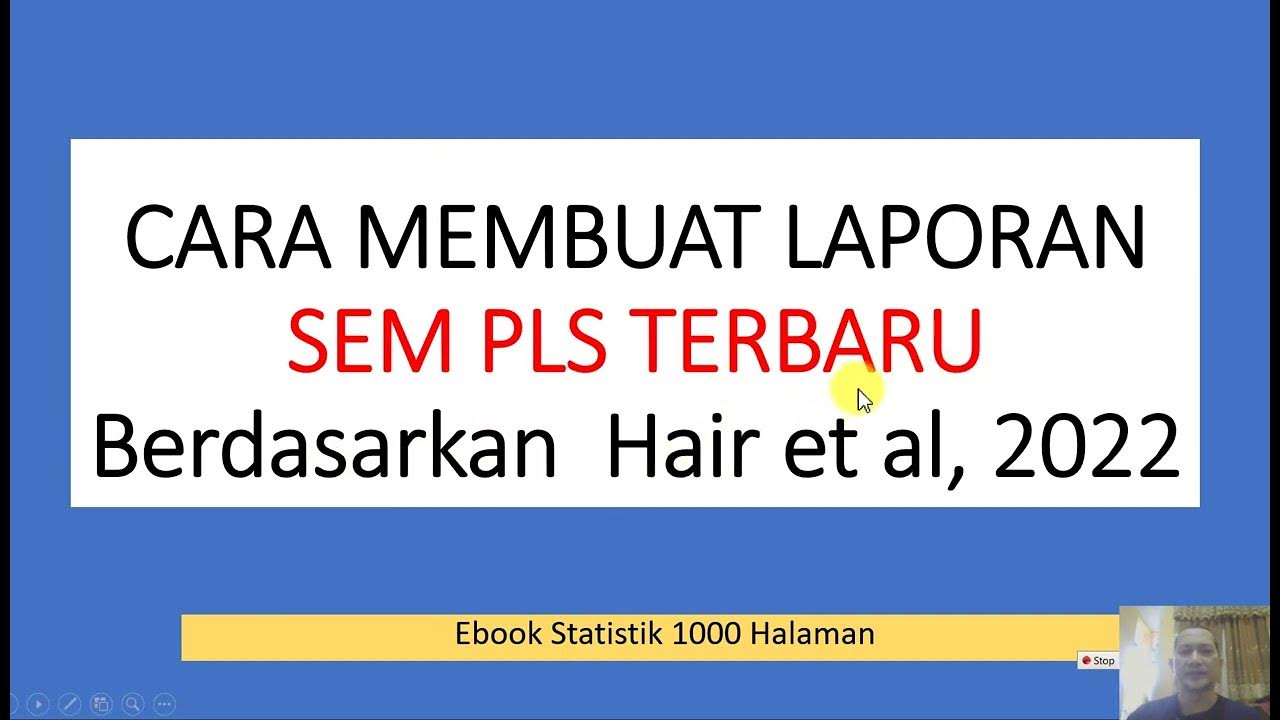TUTORIAL SEM PLS DENGAN SMARTPLS 4 & INTERPRETASINYA (BARU)
Summary
TLDRThis tutorial introduces the latest features of SmartPLS version 4, a statistical tool for evaluating reflective measurement models. It guides users through creating a project, importing data, and assessing model validity, reliability, and significance using loading factors, composite reliability, and HTMT. The tutorial covers structural model evaluation, reporting results, and calculating prediction accuracy through R-squared and RMSE values. The speaker emphasizes the practical application of these techniques in research and offers a comprehensive 1700-page statistical guide for further learning. Subscribers are encouraged to benefit from lifelong updates with their purchase of the resource.
Takeaways
- 😀 The tutorial explains how to evaluate a reflective measurement model using SmartPLS, including key steps like checking the loading factor, composite reliability, and AVE for validity.
- 😀 Convergent validity is assessed by ensuring that the loading factor is above 0.70, which confirms that items in a reflective measurement model accurately measure their intended construct.
- 😀 Discriminant validity is important to ensure that each construct is distinct from others. This can be measured by cross-loadings and Fornell-Larcker criteria, ensuring that the square root of AVE is higher than the correlation with other constructs.
- 😀 The tutorial provides a step-by-step guide on setting up a project in SmartPLS, importing data, and creating a reflective measurement model by defining and connecting constructs.
- 😀 Structural model evaluation is essential, including checking the significance of relationships between variables, multicollinearity, and examining the effect sizes of different predictors on outcomes.
- 😀 Bootstrapping is used to test the significance of paths between variables. The output helps determine if the relationships in the model are statistically significant (p-value < 0.05).
- 😀 SmartPLS allows for exporting results, although limitations exist in the student version of the software, where certain features like exporting to Excel are restricted.
- 😀 The tutorial stresses the importance of model fit metrics like R-square and Q-square to assess how well the model fits the data and its predictive power.
- 😀 The discussion on mediation tests highlights how variables like motivation can mediate the effects of other constructs, such as empowerment, on satisfaction.
- 😀 The final evaluation includes reporting key model outcomes, such as predictive power (Q-square), ensuring the results meet the required thresholds for statistical significance and goodness of fit.
Q & A
What is the primary focus of the tutorial in the video?
-The tutorial focuses on using the SmartPLS application for analyzing reflective measurement models, including evaluating convergent validity, discriminant validity, and the structural model.
What is a reflective measurement model in SmartPLS?
-A reflective measurement model in SmartPLS involves items that reflect the underlying construct, and its evaluation focuses on the relationships between indicators and their corresponding latent variables.
How does the video guide the user in evaluating convergent validity?
-The video demonstrates evaluating convergent validity by checking if the loading factors exceed 0.70, ensuring that the items are well aligned with the latent variable they measure.
What does the composite reliability (CR) measure, and how is it evaluated?
-Composite reliability measures the internal consistency of a set of indicators. It is evaluated using values above 0.70 as an acceptable threshold to indicate reliability.
What role does discriminant validity play in the analysis?
-Discriminant validity ensures that the constructs measured by the model are distinct from each other. It is assessed by checking that the square root of the AVE (Average Variance Extracted) is greater than the correlation with other constructs.
What is the significance of the t-statistic in the analysis?
-The t-statistic is used to assess the significance of relationships between variables. A t-statistic greater than 1.96 indicates that the relationship is statistically significant.
How do you evaluate the structural model in SmartPLS?
-The structural model is evaluated by assessing the path coefficients, R-square values, and checking for multicollinearity, among other model fit indicators.
What does the R-square value indicate in a structural model?
-The R-square value indicates the proportion of variance in the dependent variable that is explained by the independent variables. Higher values suggest a better fit of the model.
What does a bootstrap procedure in SmartPLS do?
-A bootstrap procedure in SmartPLS helps assess the stability of the estimates by generating resampling statistics, including t-statistics, to test the significance of the paths in the model.
What does the video suggest about the influence of motivation on job satisfaction?
-The video indicates that motivation has a significant positive influence on job satisfaction, with empowerment also contributing, while religiosity does not directly affect satisfaction.
Outlines

This section is available to paid users only. Please upgrade to access this part.
Upgrade NowMindmap

This section is available to paid users only. Please upgrade to access this part.
Upgrade NowKeywords

This section is available to paid users only. Please upgrade to access this part.
Upgrade NowHighlights

This section is available to paid users only. Please upgrade to access this part.
Upgrade NowTranscripts

This section is available to paid users only. Please upgrade to access this part.
Upgrade NowBrowse More Related Video

Tutorial PLS SEM menggunakan smartPLS lengkap dengan interpretasi output #pemula

TUTORIAL SMARTPLS 4: CARA MEMBUAT LAPORAN SEM PLS REFERENSI HAIR ET AL, 2022 (TERBARU)

Cline (ClaudeDev) UPDATE: The BEST AI Coding Agent! (Real-Time Edits, Rebranded, etc!)

How To Go In Game With All Skins in Fortnite! | Skins | Troll People! | Fortnite Dev | NL Hybrid |

G*Power 3.1 Tutorial: Overview (Episode 1)

PLS SEM Second Order menggunakan smartPLS Pada Indikator Refleksif
5.0 / 5 (0 votes)